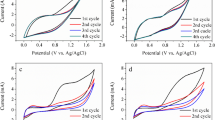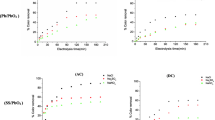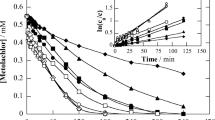Abstract
Electrochemical removal of synthesis solution containing 50 mg/L auramine-O through Ti/PbO2 electrodes and carbon felt air-diffusion electrode to in situ generate hydrogen peroxide (H2O2) by the oxygen (O2) reduction. The effects of operating conditions, FeSO4·7H2O concentrations, current density, initial concentration, initial pH value and sodium sulfate (Na2SO4) concentration were investigated. For reaction of 60 min, the auramine-O removal rate reached 99% and total organic carbon (TOC) removal rate was close to 64.27%. This means that the organic macromolecules in the pollutants have been completely destroyed and broken down. The degradation of auramine-O under electro-Fenton (EF) process using Ti/PbO2-carbon felt was analyzed from the dimensions of TOC, mineralization current efficiency, energy consumption, degradation mechanism and kinetics. Comparing EF-Ti/PbO2 with Ti/PbO2 anode, AO (anodic oxidation)-Ti/PbO2 anodic oxidation using Ti/PbO2 anode and EF-Pt EF process with Pt anode, the consequences demonstrated that Ti/PbO2-EF process by hydrogen peroxide produced in situ was the best choice than others.









Similar content being viewed by others
References
Arredondo Valdez HC, García JG, Gutiérrez GS, de Ponce LC (2012) Degradation of paracetamol by advance oxidation processes using modified reticulated vitreous carbon electrodes with TiO2 and CuO/TiO2/Al2O3. Chemosphere 89:1195–2011
Aydinoglu S, Pasti A, Biver T, Mennucci B (2019) Auramine-O interaction with DNA: a combined spectroscopic and TD-DFT analysis. Phys Chem Chem Phys 21:06–12
Bandyopadhyay S, Boukhvalov DW, Nayak AK, Ha SR, Shin HJ, Kwon J, Song T, Choi H (2019) Redox active nitrogen-containing conjugated porous polymer: an organic heterogeneous electrocatalysts for oxygen reduction reaction. Dyes Pigments 170:107–557
Brillas E, Martinez-Huitle CA (2015) Decontamination of wastewaters containing synthetic organic dyes by electrochemical methods. An updated review. Appl Catal B Environ 166–167:603–643
Brillas E, Sirés I, Mehmet AO (2009) EF process and related electrochemical technologies based on Fenton’s reaction chemistry. Chem Soc Rev 109:6570–6631
Cagnetta C, Saerens B, Meerburg FA, Decru SO, Broeders E, Menkveld W, Vandekerckhove TG, De Vrieze J, Vlaeminck SE, Verliefde AR (2019) High-rate activated sludge systems combined with dissolved air flotation enable effective organics removal and recovery. Bioresour Technol 291:121833
Deng FX, Li SX, Zhou MH, Zhu YS, Qiu S, Li KH, Ma F, Jiang JZ (2019) A biochar modified nickel-foam cathode with iron-foam catalyst in electro-Fenton for sulfamerazine degradation. Appl Catal B Environ 256:117796
Dirany A, Sirés I, Oturan N, Özcan A, Oturan MA (2012) Electrochemical treatment of the antibiotic sulfachloropyridazine: kinetics, reaction pathways, and toxicity evolution. Environ Sci Technol 46:4074–4082
Elaoud SC, Panizza M, Cerisola G, Mhiri T (2012) Coumaric acid degradation by EF process. J Electroanal Chem 667:19–23
Farooqa MU, Jaleesa MI, Iqbala A, Zahraa N, Kirana A (2019) Characterization and adsorption study of biosorbents for the removal of basic cationic dye: kinetic and isotherm analysis. Desalination Water Treat 160:333–422
Ganiyu SO, Zhou M, Martínez-Huitle CA (2018) Heterogeneous EF and photoEF processes: a critical review of fundamental principles and application for water/wastewater treatment. Appl Catal B Environ 235:103–129
Gao M, Zhang G, Wang X, Yang F (2012) The bromamine acid removal from aqueous solution using EF and Fenton systems. Desalination Water Treat 47:157–162
Hmani E, Samet Y, Abdelhédi R (2012) Electrochemical degradation of auramine-O dye at boron-doped diamond and lead dioxide electrodes. Diam Relat Mater 30:1–8
Labiadh L, Oturan MA, Panizza M, Hamadi NB, Ammar S (2015) Complete removal of AHPS synthetic dye from water using new EF oxidation catalyzed by natural pyrite as heterogeneous catalyst. J Hazard Mater 297:34–41
Liu T, Wang K, Song S, Brouzgou A, Tsiakaras P, Wang Y (2016) New EF gas diffusion cathode based on nitrogen-doped graphene@ carbon nanotube composite materials. Electrochim Acta 194:228–238
Lizama-Bahena C, Álvarez-Gallegos A, Hernandez JA, Silva-Martinez S (2015) Elimination of bio-refractory chlorinated herbicides like atrazine, alachlor, and chlorbromuron from aqueous effluents by Fenton, EF, and peroxi-coagulation methods. Desalination Water Treat 55:3683–3693
Martínez-Huitle CA, Ferro S (2006) Electrochemical oxidation of organic pollutants for the wastewater treatment: direct and indirect processes. Chem Soc Rev 35:1324–1340
Martínez-Huitle CA, Panizza M (2018) Electrochemical oxidation of organic pollutants for wastewater treatment. Curr Opin Electrochem 11:62–71
Martínez-Huitle CA, Rodrigo MA, Sires I, Scialdone O (2015) Single and coupled electrochemical processes and reactors for the abatement of organic water pollutants: a critical review. Chem Rev 115:13362–13407
Oturan MA (2014) Electrochemical advanced oxidation technologies for removal of organic pollutants from water. Environ SCI Pollut 21:8333–8335
Oturan N, Panizza M, Oturan MA (2009) Cold incineration of chlorophenols in aqueous solution by advanced electrochemical process EF. Effect of number and position of chlorine atoms on the degradation kinetics. J Phys Chem A 113:10988
Oturan N, Brillas E, Oturan MA (2012) Unprecedented total mineralization of atrazine and cyanuric acid by anodic oxidation and EF with a boron-doped diamond anode. Environ Chem Lett 10:165–170
Özcan A, Yücel Şahin A, Koparal S, Oturan MA (2008) Degradation of picloram by the EF process. J Hazard Mater 153:718–727
Panizza M, Cerisola G (2009) Direct and mediated anodic oxidation of organic pollutants’. Chem Rev 109:6541
Panizza M, Oturan MA (2011) Degradation of Alizarin Red by EF process using a graphite-felt cathode. Electrochim Acta 56:7084–7087
Poza-Nogueiras V, Rosales E, Marta Pazos M, Sanromán Á (2018) Current advances and trends in EF process using heterogeneous catalysts—a review. Chemosphere 201:399–416
Przystas W, Zablocka-Godlewska E, Grabinska-Sota E (2019) Pleurotus ostreatus as a species with potentially high effectiveness in the removal of synthetic dyes belonging to different classes. Desalin Water Treat 161:376–386
Rao ANS, Venkatarangaiah VT (2014) Metal oxide-coated anodes in wastewater treatment. Environ Sci Pollut Res 21:3197–3217
Salari D, Niaei A, Khataee A, Zarei M (2009) Electrochemical treatment of dye solution containing C.I. Basic Yellow 2 by the peroxi-coagulation method and modeling of experimental results by artificial neural networks. J Electroanal Chem 629:117–125
Sennaoui A, Alahiane S, Sakr F, El Ibrahimi B, El Issami S, Assabbane A (2018) EF degradation of trimellitic and pyromellitic acids: kinetics and mechanism. Electrocatalysis 9:716–724
Sires I, Garrido JA, Rodriguez RM, Brillas E, Oturan N, Oturan MA (2007) Catalytic behavior of the Fe3+/Fe2+ system in the EF degradation of the antimicrobial chlorophene. Appl Catal B Environ 72:382–394
Sirés I, Brillas E, Oturan M, Rodrigo M, Panizza M (2014) Electrochemical advanced oxidation processes: today and tomorrow. A review. Environ Sci Pollut Res 21:8336–8367
Tang W, Xiaolin X, Ye BC, Cao P, Ali A (2019) Decolorization and degradation analysis of Disperse Red 3B by a consortium of the fungus Aspergillus sp. XJ-2 and the microalgae Chlorella sorokiniana XJK. RSC Adv 9:14558–14566
Tung J-C, Huang W-C, Yang J-C, Chen Guan-Yu, Fan C-C, Chien Y-C, Lin P-S, Lung S-CC, Chang W-C (2017) Auramine-O, an incense smoke ingredient, promotes lung cancer malignancy. Environ Toxicol 32:2379–2391
Xu Y, Wang L, Yin X, Zhang S, Li S, Dou Y (2019) Effects of dissolved oxygen on sludge reduction and microbial community structure in sequencing batch reactors. Desalination Water Treat 161:56–65
Yadav G, Dash SK, Sen R (2019) A biorefinery for valorization of industrial waste-water and flue gas by microalgae for waste mitigation, carbon-dioxide sequestration and algal biomass production. Sci Total Environ 688:129–135
Yang L, Sheng M, Zhao H, Qian M, Chen X, Zhuo Y, Cao G (2019a) Treatment of triethyl phosphate wastewater by Fenton oxidation and aerobic biodegradation. Sci Total Environ 678:821–829
Yang Y, Qiao S, Zhou J, Quan X (2019b) A novel porous-carbon-based hollow fiber membrane with electrochemical reduction mediated by in situ hydroxyl radical generation for fouling control and water treatment. Appl Catal B Environ 255:117772
Yao Y, Huang C, Yang Y, Li M, Ren B (2018) Electrochemical removal of thiamethoxam using three-dimensional porous PbO2–CeO2 composite electrode: electrode characterization, operational parameters optimization and degradation pathways. Chem Eng J Chem Eng J 350:960–970
Zheng Y, Qiu S, Deng F, Zhu Y, Li G, Ma F (2019) Three-dimensional EF system with iron foam as particle electrode for folic acid wastewater pretreatment. Sep Purif Technol 224:463–474
Acknowledgments
This work was supported by the National Natural Science Foundation of China (Nos. 21576065, 21402038) and the Natural Science Foundation of Hebei Province of China (B2020202016, B2019202003).
Author information
Authors and Affiliations
Corresponding author
Ethics declarations
Conflict of interest
The authors declare no competing financial interest.
Rights and permissions
About this article
Cite this article
Sun, W., Yao, Y. Degradation of Auramine-O in Aqueous Solution by Ti/PbO2-Electro-Fenton Process by Hydrogen Peroxide Produced In Situ. Iran J Sci Technol Trans Sci 45, 145–154 (2021). https://doi.org/10.1007/s40995-020-00975-4
Received:
Accepted:
Published:
Issue Date:
DOI: https://doi.org/10.1007/s40995-020-00975-4




